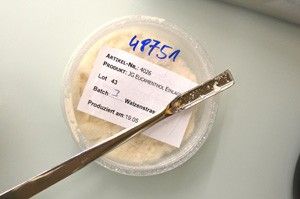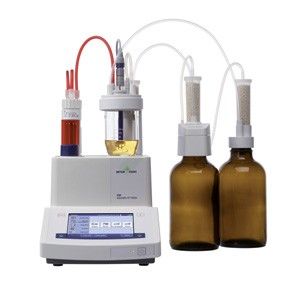Sweet but no sugar please, plus long-lasting taste and the right consistency. To create perfect chewing gum, you need butyl rubber, flavorings, sweeteners, and the necessary expertise. Products from METTLER TOLEDO are also a must.
The Swiss confectionery maker Chocolat Frey makes more than just chocolate. Forty years ago, chewing gum production was already the second largest segment of its business. Today, with an annual production of 5,000 tons, it is one of Europe's major suppliers. A large share of the gum, about 80%, is produced for the export market. The remainder is delivered to the shelves of Migros, the Swiss supermarket chain.
 The rise of chewing gum
The rise of chewing gum
Chewing gum has been around since long before the individual sticks of spearmint, cinnamon or wild cherry appeared at supermarket checkouts. Our ancestors regarded chewing gum as a stimulant and a remedy. During the excavation of pile-dwelling settlements from the Neolithic Period, archaeologists in Zurich discovered two pieces of "chewing gum" made of birch tar that clearly showed the imprint of teeth. The chewing gum base obtained from birch bark contains betulin – a substance that has anti-inflammatory, antibacterial, and narcotic properties. In other words: it provided pain relief and accelerated the healing process.
Today, people chew gum to freshen their breath, to reduce the risk of tooth decay or simply to pass the time. But what makes the perfect chewing gum? "Chewing gum is essentially a highly sensory experience," explains Robert Tylla, who is responsible for quality assurance in the laboratory at Chocolat Frey. "What does it look like, is it nicely sugar-coated, does it crackle when you first bite it? What is the initial taste sensation?" The chewing gums produced by Chocolat Frey, for instance, come in a variety of flavors that range from fresh (Spearmint) to tart (Sparkling Fruits) and intense (Air Boost). Chewing gum retains its flavor for around five minutes; thereafter, it lands in the trash or as a non-biodegradable spot on the sidewalk.
 Quality control
Quality control
Each new flavor of gum must pass the sensory tests performed in the development department. This is followed by a chemical analysis. To ensure consistent quality, Robert Tylla and the laboratory team test each new product: "We inspect the ingredients and make sure they match the recipe." A consistent quality level of quality is essential to ensure the gum always tastes the same. But this is not the only reason for the stringent checks. "From a legal perspective, the gum must contain exactly what is listed on the label. The information on the packet had to be correct," the expert explains.
The testing lasts one to two days for each flavor of gum and includes the determination of water content using a Karl Fischer Titrator (KFT) from METTLER TOLEDO. "There is always a danger of bacterial growth if water is present in a product. Chewing gum should therefore contain virtually no water," stresses Robert Tylla. In order to check the water content with the Karl Fischer Titrator, the chewing gum is placed in a freezer overnight. Then it is ground into a granulate material, mixed with a reagent solution in the KFT and titrated. "Ideally, the analysis will show that the product contains practically no water," explains Robert Tylla. However, if water is unexpectedly found in the product, the production team must find out which raw material was responsible for introducing water into the product.
Karl Fischer at METTLER TOLEDO
The Karl Fischer method was developed in 1935 by the German chemist Karl Fischer. Today, it is the most frequently used titration method worldwide. No other method determines water content faster and more specifically. For almost 40 years, METTLER TOLEDO has been developing Karl Fischer Titrators and has pioneered some leading innovations in this field. "Today, our devices are among the most accurate on the market," Lukas Candreia, Head of Titration, reports with pride.
 In addition to the food industry, Karl Fischer Titrators are used in various other sectors – such as the pharmaceutical and chemical industries. Customers value their easy and safe operation as well as their precision. "The chemicals required for Karl Fischer titration, are methanol-based and toxic. Obviously, users should not come into contact with them," says Lukas Candreia. The Karl Fischer Titrator solves this problem with the "Solvent Manager". This component is built into the device and enables automatic filling, purging and replacement of the solvent.
In addition to the food industry, Karl Fischer Titrators are used in various other sectors – such as the pharmaceutical and chemical industries. Customers value their easy and safe operation as well as their precision. "The chemicals required for Karl Fischer titration, are methanol-based and toxic. Obviously, users should not come into contact with them," says Lukas Candreia. The Karl Fischer Titrator solves this problem with the "Solvent Manager". This component is built into the device and enables automatic filling, purging and replacement of the solvent.
Before the automated Karl Fischer Titrator came into use, titration was carried out manually with a glass burette. "In Switzerland, this was the method used well into the 1980s. You can still sometimes see it used in less-developed countries," says Lukas Candreia. However, this method is much less accurate – not to mention less safe for the user. Ultimately, it is cheaper to use the equipment, as Lukas Candreia knows: "The reagents required for the process are very expensive. The KFT uses approximately two milliliters per titration. The manual method uses much more. What you save by not purchasing the device, you spend on chemicals. The other alternative would be to buy low-quality chemicals, but then the result will be highly inaccurate. For reliable results, you need the right equipment."
This is a sentiment shared by the quality assurance experts at Chocolat Frey. Since 2008, the laboratory has been well-served by the KFT model DL38, ensuring that the popular chewing gum tastes as good tomorrow as it does today.
